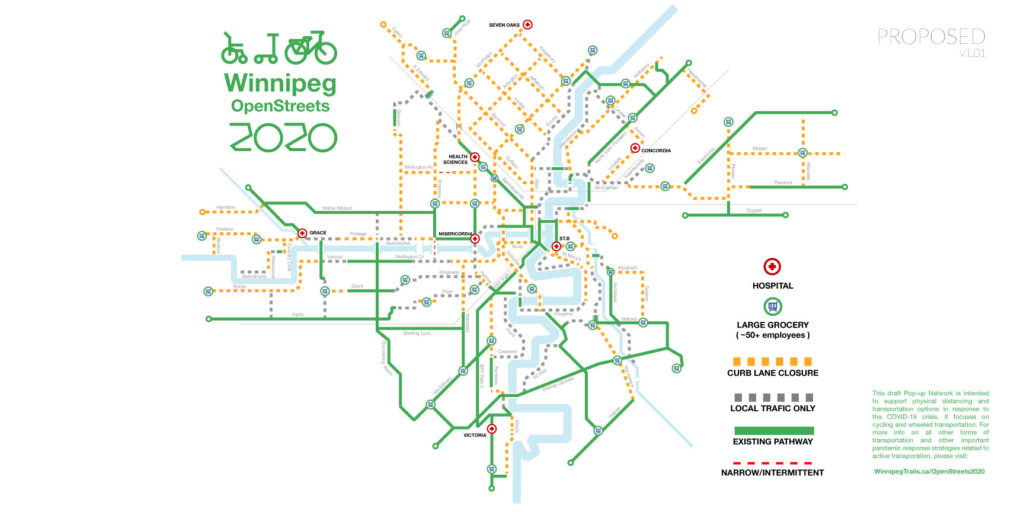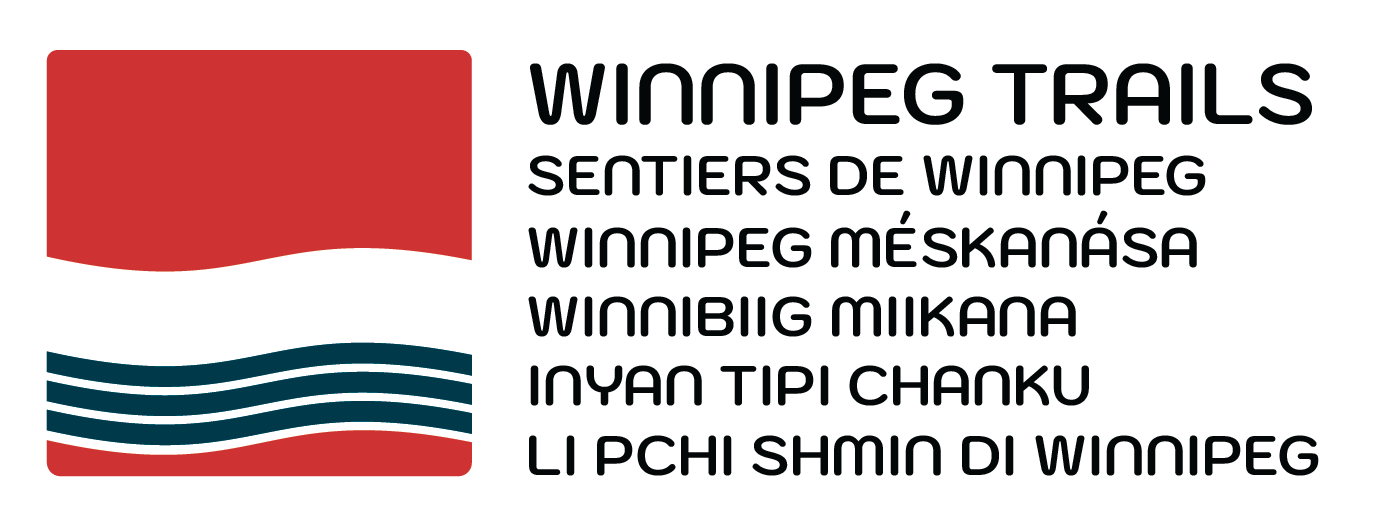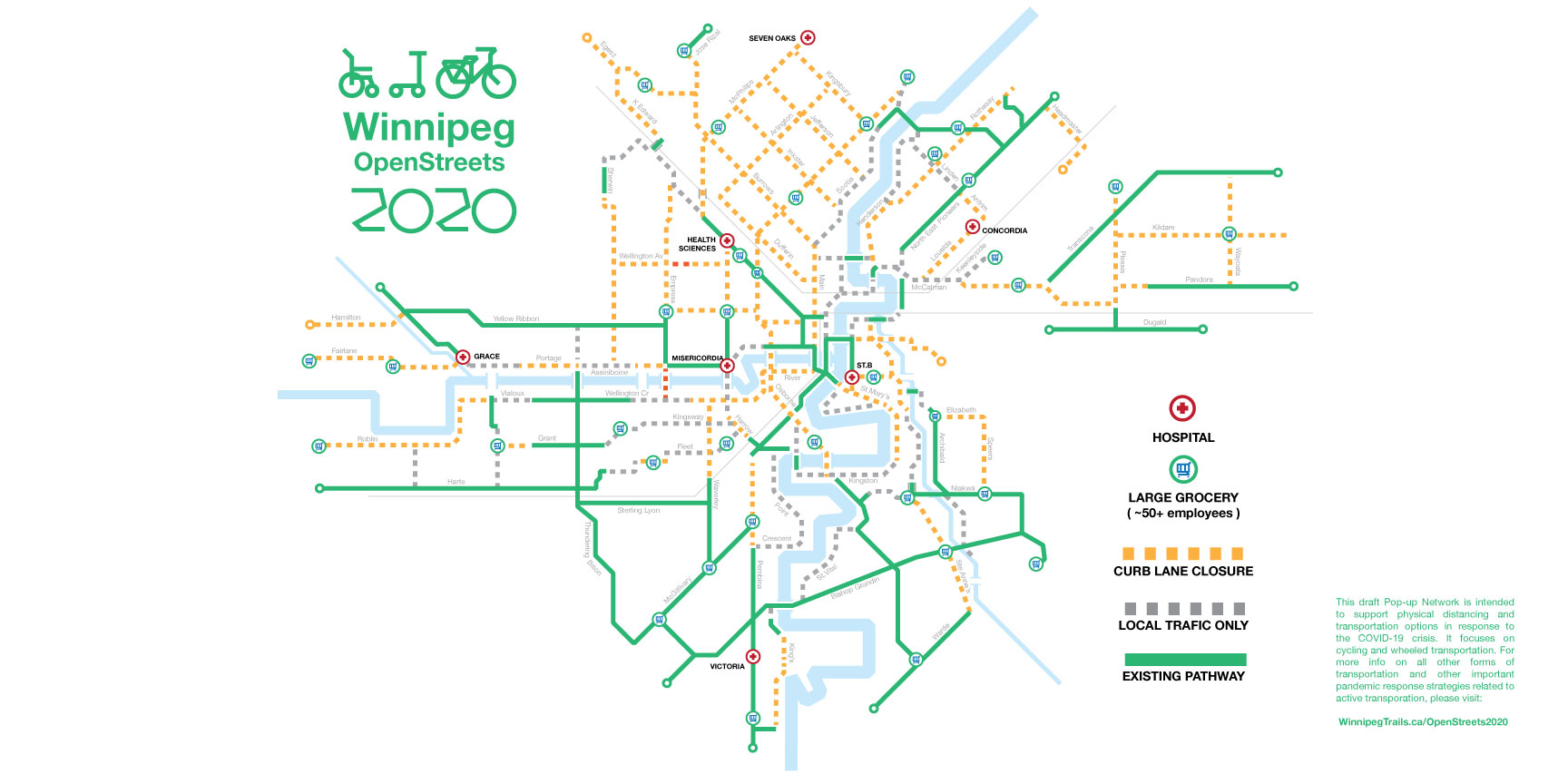
What do you do when up to 168,000 passenger daily transit trips suddenly need to be repurposed? Where do kids and families go to get exercise when most recreation centres, pools and playgrounds suddenly close? How do you help a city bounce back in the face respiratory disease pandemic?
Winnipeg would benefit from the rapid deployment of a safer, connected cycling network reaching every neighbourhood and safer streets right our your front door.
This plan will support physical distancing and offer, family-friendly, healthy mobility and a future of fresh air. It will leverage community support and effort, repurpose empty and underused infrastructure and make the most of a bad situation.
On this page, you can find out what streets have already been opened and find out what you can do to create more. We want it to happen fast, for you. We would like your support, your voice, your ideas and your feedback.
What streets are already open? The City of Winnipeg has taken some small initial steps while it figures out what to do. On April 6th, parts of Wellington, Lyndale, Scotia and Wolseley became local traffic only. On April 22nd, another six local traffic only streets were announced.
Our Open Streets Vision for Winnipeg
We envision a pandemic response vision that consists of 4 key pieces:
a. Immediate Medium-Distance Transport Options. OpenStreets2020 starts with our proposal for an emergency cycling network. It is a “minimum grid” network suitable for all ages and abilities. When implemented, a route consisting of a open streets and/or lane conversions should fall within ~500m of everyone’s home and/or destination. This component is high priority and consider key for supporting a beleaguered transit system.
b. Safety Out Your Front Door. Promoting family-friendly speed policy and tactical urbanism on every residential street, including yours. Every trail starts at home. Mimicking what is already happening, we would like to see the spirit of co-ownership of public space, including the roadway, become more common.
c. More Room for Pedestrians. We are advocating for further lane re-dedications around key destinations, parking policy changes and pathway widenings wherever needed to create more comfort and room for people on foot, especially in areas not on the minimum grid, but where pedestrian traffic is expected to be congested.
d. Economic Recovery Aided by Healthy Infrastructure Construction. We want to see clean air, connected paths and better sidewalks become the new normal. We are working on infrastructure project ideas that will improve safety and fill gaps.
Have a look at the first piece, the minimum grid map below. (See large PDF version to zoom more easily). This map shows existing pathways (in green), proposed curb lane closures (dashed orange) and local traffic-only Sunday street style roads (dashed grey) all joined up in to create a fun, practical and healthy impromptu bicycle path network.

We want to know: Would this make your life better or easier?
Would this make your city a better healthier place to live?
Is the map missing something? Please take a moment to think about this map and fill out this questionnaire.
Why is active transportation especially important now?
- Transit plan B According to the census, 57,000 people rely on a bus every day to get to work. There are approximately 168,000 passenger trips on Winnipeg Transit every day. People have significant concerns about social distancing until a vaccine is found and it will last. Its begun and transit ridership is already at 20% and expected to take a long time to recover. How can we avoid the additional road safety and environmental concerns of additional driving. We are also deeply concerned that plunging revenues will lead to reduced transit service, making independent modes more desirable.
- Creating more space for pedestrians. Curb lane closures give a pedestrian somewhere to step to and a wheelchair user somewhere she can keep physical distance. Open and shared streets give people places to walk and helps avoid the many 1.5m sidewalks (we are also advocating for 30km/hr sweeping policy change too)
- Air Pollution and the pandemic. – Air pollution which has been tied to higher mortality rates from COVID-19
- Physical inactivity. Numerous chronic diseases put you at risk of COVID-19 and most of them have roots in a sedentary lifestyle. This is a wake up call. The best way to get people moving is to embed low impact physical activity into our lifestyle. More trips to the store on foot. Biking to work when it feels safe.
- Streets are empty. No one likes the cause, but if there is a positive side, its the fact with major disruptions in the status quo, we can offer healthy options more easily then we could before.
- Kids and Safety. With car volumes at levels we have not seen in decades, and parents avoiding narrow sidewalks, children have returned to playing/walking/riding in streets near their homes. We owe it to them not to go back.
- Inexpensive transportation. The globe itself is in for a prolonged recession. The full effect is only starting to kick. We need need cheap and healthy options for people to get to grocery stores and work.
- People, more than ever, want to be healthy and stay healthy. This pandemic has unlocked a deeper appreciation in society for the ability to go outside and connect. There is no going back from this. Healthy, practical solutions to make us healthy and save the planet are going to be deeply popular for years to come.
How will it work?
It can be easy. The City of Winnipeg has the capacity to use cones to add multiple kms of curb lane for special events. Ciclovia or the Manitoba Marathon are great examples of what can be accomplished even in the few hours before dawn by 1 or 2 crews. For more than thirty years, Winnipeg has been opening long stretches of streets with a few simple barricades, of the type found by the thousands at maintenance yards and construction companies all over the city.
Cities across Canada are getting creative and moving quickly.
We don’t need ugly pylons forever, either. We have collected best practices, found suppliers for things like concrete planters, and even developed our own solutions to known problem areas like bus stop transition areas thanks to in house engineer.
In the end, short of dragging planters and picnic tables into our streets (which some councillors have even suggested), it is up to our city to do the right thing.
Who else thinks their city should do this? pic.twitter.com/AQeJTBwJ8i
— Anders Swanson (@SwansonAnders) April 9, 2020
What is, far and away, the world’s most popular hobby? Gardening. Gardening, technically speaking is more popular than we kid you not) sex. So imagine what would happen if we combined street design with more greenery. Here’s a great example of just how simple and beautiful the infrastructure changes we are proposing can be. Imagine this kind of thing in your neighbourhood. Did you know that some of the newest and wealthiest neighbourhoods already embody these principles. Of course, we need to do better at making sure you don’t need a car to live in one, but it means that we already know how important low speeds and traffic calming are. See below. With designs like this added in after the fact, you don’t have to live on a street ending in “Cove” or “Bay” or “Place” to have natural traffic calming features that send a message to everyone that your street that “hey, isn’t a speeding free for all, this is somewhere I ride my bike and my kids play”:
Traffic calming community garden chicanes and recreational center. pic.twitter.com/UNdzdiMhlg
— Dongho Chang (@dongho_chang) April 24, 2020
What can I do to make a network happen?
Share this idea on Twitter, Facebook and Instagram. Let your councillor, MLA and MP know what that you feel this is important.
My street too! We are also calling for Winnipeggers to be encouraged to use what’s called “tactical urbanism” principles to create safer or healthier spaces.
Got to love when the residents take over the streets making room for #Play #TacticalUrbanism https://t.co/hPEBfqPwKP
— Winnipeg in motion (@Wpginmotion) April 20, 2020
Is this kind of thing happening near you? We want to know about it.
If you are seeing your street used differently by children, or have taken steps to keep everyone safer, we’d like to hear about it.
Winnipeg Trails and COVID-19 timeline
- In early March like the rest of Canada, we began to monitor the warnings coming from our health authorities and being sure to align with their message and keep people safe. We began to focus on the healthy physical activity piece and keeping people informed. Staff reached out to the local health authority for guidance and began to prepare our messaging.
- On March 18th, just as the situation in Canada was awakening to the seriousness of the coronavirus outbreak, we wrote a public post that included a call for a comprehensive and temporary bike network as a rapid response .
- We began to work behind the scenes to share its importance with elected municipal officials so they could begin developing and rolling out a plan, including potential network maps and strategies.
- When we were interviewed for this story on this March 31st, Limited plans had been announced for the early opening of 4 “sunday streets” sections on a daily basis.
- Other cities and eventually communities all across Canada began initial preparations too. That list is ever growing.
- Staff and volunteers began combing through bicycles and parts leftover from our Plain Bikes project and offered two month free bicycle loans to people affected by the shutdowns.
- On April 21st, our executive director appeared at the Public Works Standing policy committee to talk about speed limit reductions, road safety and the cycling network plan. He lays out the reasons for doing at 52:30 here. Councillor’s Sharma and Allard ask the public service for an update. You can hear the Public Service response here. Later, that day Chair of Public Works, Councillor Allard announced 6 additional street sections would be added to the week long Sunday closures. Winnipeg Trails staff and board continue to seek urgency and action.
- In response to high levels of expressed desire, increasing usage, and concerns about impending transit cuts without a robust Plan B for active transportation, we created the page you are reading to share our work publicly, solicit feedback and track open streets and curb lane closures as we build a network.
- On April 22nd, Winnipeg Transit announced major service cutbacks:
Winnipeg Transit reduces service, lays off more than 250 staffhttps://t.co/Cje1vDrJuA
— CBC Manitoba (@CBCManitoba) April 22, 2020
- Friday April 24th, Winnipeg Trails’ open streets and mobility plan is discussed during media scrum at COVID-19 regular press conference:
- Saturday April 25th, the Winnipeg Free Press profiled the network





